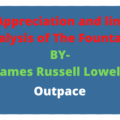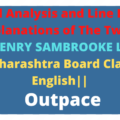About the Poet
Robert Browning was an English writer and writer whose dominance of the emotional discourse made him one of the chief Victorian artists. Conceived on May 7,1812, his sonnets are known for their incongruity, portrayal, dull humour, social editorial, authentic settings, and testing jargon and punctuation.
Carmelizing’s initial vocation started promisingly, however, crumbled. The long sonnets Pauline (1833) and Paracelsus (1835) got some praise, yet in 1840 the troublesome Sordello, which was viewed as wilfully dark, brought his verse into offensiveness. His notoriety took over 10 years to recuperate, during which time he moved away from the Shelleyan types of his initial period and built up closer to home style.
In 1846 Browning wedded the more established writer Elizabeth Barrett and went to live in Italy. When of her demise in 1861 he had distributed the urgent assortment Men and Women (1855). The assortment Dramatis Personae (1864) and the book-length epic sonnet The Ring and the Book (1868-1869) followed and made him a main British artist. He kept on composing productively, yet his notoriety today lays generally on the verse he wrote in this centre period.
When Browning passed on in 1889, he was viewed as a sage and logician artist who through his composing had made commitments to Victorian social and political talk. Abnormally for an artist, social orders for the investigation of his work framed while he was as yet alive. Such Browning Societies stayed regular in Britain and the United States until the mid-twentieth century.
Robert Browning was conceived in Walworth in the ward of Camberwell, Surrey, which presently shapes part of the Borough of Southwark in south London. He was submerged on 14 June 1812, at Lock’s Fields Independent Chapel, York Street, Walworth, the main child of Sarah Anna (née Wiedemann) and Robert Browning. His dad was a generously compensated assistant for the Bank of England, winning about £150 every year. Cooking’s fatherly granddad was a slave proprietor in Saint Kitts, West Indies, however, Browning’s dad was an abolitionist. Sautéing’s dad had been sent toward the West Indies to deal with a sugar ranch, in any case, because of a slave revolt there, had come back to England. Carmelizing’s mom was the little girl of a German shipowner who had settled in Dundee in Scotland, and his Scottish spouse. Searing had one sister, Sarianna. Sautéing’s fatherly grandma, Margaret Tittle, who had acquired an estate in St Kitts, was reputed (inside the family) to have a blended race lineage, including some Jamaican blood, however, creator Julia Markus recommends she was Kittitian as opposed to Jamaican. By 12, Browning had composed a book of verse which he later pulverized when no distributor could be found. Subsequent to being at a couple of tuition-based schools, and indicating an insuperable abhorrence of school life, he was instructed at home by a guide by means of the assets of his dad’s broad library. By 14 he was familiar with French, Greek, Italian and Latin. He turned into an extraordinary admirer of the Romantic writers, particularly Shelley. Following the point of reference of Shelley, Browning turned into a nonbeliever and vegan. At 16, he examined Greek at University College London yet left after his first year. His folks’ steadfast zealous confidence forestalled his learning at either Oxford or Cambridge University, both at that point open just to individuals from the Church of England. The poet had acquired considerable melodic capacity through his mom and made game plans out of different tunes. He denied a conventional profession and disregarded his folks’ criticisms, devoting himself to verse. the poet remained at home until the age of 34, monetarily subject to his family until his marriage. His dad supported the distribution of his child’s sonnets.
In March 1833, “Pauline, a Fragment of a Confession” was distributed secretly by Saunders and Otley to the detriment of the creator, Robert Browning, who got the cash from his auntie, Mrs Silverthorne. It is a long sonnet formed in reverence to Shelley and to some degree in his style. n 1834, he went with the Chevalier George de Benkhausen, the Russian representative general, on a short visit to St Petersburg and started Paracelsus, which was distributed in 1835. The subject of the sixteenth-century intellectual and chemist was most likely recommended to him by the Comte Amédée de Ripart-Monclar, to whom it was committed. Because of his new contacts, he met Macready, who welcomed him to compose a play. Strafford was performed multiple times. Cooking at that point composed two different plays, one of which was not performed, while the other fizzled, Browning, having dropped out with Macready.
In 1838, he visited Italy searching for the foundation for Sordello, a long sonnet in courageous couplets, introduced as the fanciful life story of the Mantuan versifier talked about by Dante in the Divine Comedy, Canto 6 of Purgatory, set against a foundation of scorn and struggle during the Guelph-Ghibelline wars. This was distributed in 1840 and met with across the board mocking, picking up him the notoriety of wanton imprudence and lack of definition. Tennyson remarked that he just comprehended the first and last lines and Carlyle composed that his significant other had perused the sonnet and couldn’t tell whether Sordello was a man, a city or a book.
Cooking’s notoriety started to make a fractional recuperation with the distribution, 1841–1846, of Bells and Pomegranates, a progression of eight leaflets, initially proposed just to incorporate his plays. Luckily for Browning’s profession, his distributor, Moxon, convinced him to incorporate some “sensational verses”, some of which had just shown up in periodicals.
In 1845, Browning met the writer Elizabeth Barrett, six years his senior, who lived as a semi-invalid in her dad’s home in Wimpole Street, London. They started consistently relating and continuously a sentiment created between them, prompting their marriage and excursion to Italy (for Elizabeth’s wellbeing) on 12 September 1846. The marriage was at first mystery since Elizabeth’s tyrannical dad objected to marriage for any of his youngsters. Mr Barrett excluded Elizabeth, as he accomplished for every one of his youngsters who wedded: “The Mrs Sautéing of well-known creative mind was a sweet, blameless young lady who endured unlimited brutalities on account of an overbearing father yet who regardless had the favourable luck to begin to look all starry eyed at a running and attractive writer named Robert Browning.” At her better half’s demand, the second version of Elizabeth’s Poems incorporated her adoration pieces. The book expanded her prevalence and high basic respect, establishing her situation as a famous Victorian artist. Upon William Wordsworth’s demise in 1850, she was a genuine competitor to become Poet Laureate, the position, in the long run, going to Tennyson.
In Florence, likely from right off the bat in 1853, Browning dealt with the sonnets that in the end included his two-volume Men and Women, for which he is presently well known,[15] despite the fact that in 1855 when they were distributed, they had generally little effect.
In 1861, Elizabeth passed on in Florence. Among those whom he discovered supporting in that period [ was the writer and artist Isa Blagden, with whom he and his significant other had a voluminous correspondence. The next year Browning came back to London, taking Pen with him, who by then was 12 years of age. They made their home in 17 Warwick Crescent, Maida Vale. It was just when he turned out to be a piece of the London scholarly scene—but while paying successive visits to Italy (however never again to Florence)— that his notoriety began to take off.
In 1868, following five years’ work he finished and distributed the long clear section sonnet The Ring and the Book. In light of a tangled homicide case from 1690s Rome, the sonnet is made out of 12 books: basically, 10 extensive emotional speeches described by different characters in the story, indicating their individual points of view on occasions, bookended by a presentation and end by Browning himself. Long even by all accounts (more than 20,000 lines), The Ring and the Book was his most eager task and is apparently his most noteworthy work; it has been known as a masterpiece of emotional verse. Distributed in four sections from November 1868 to February 1869, the sonnet was a triumph both financially and basically, lastly presented to Browning the fame he had looked for almost 40 years. The Robert Browning Society was shaped in 1881 and his work was perceived as having a place inside the British artistic ordinance.
Sautéing kicked the bucket on December 12, 1889, at his child’s home Ca’ Rezzonico in Venice on 12 December 1889. He was covered in Poets’ Corner in Westminster Abbey; his grave presently lies quickly neighbouring that of Alfred Tennyson.
About the Poem
“Meeting at Night” is a sonnet by Victorian writer Robert Browning, which follows the excursion of its speaker to a gathering with a darling. The sonnet (like others of the 1845 assortment) was composed during the romance time of Browning with his future spouse Elizabeth Barrett. Kennedy and Hair depict the sonnet as the “most erotic sonnet” he had reviewed to that time. The sonnet made by Robert Browning is essentially centering in the need of a direness and want for a sweetheart to meet the dearest. This sonnet uncovers that arriving at our objective is significant however what is more significant for us is to appreciate the excursion. The sonnet centers around the speaker’s expectation of the gathering and the phases of his excursion.
Background of the Poem
The sonnet by Robert Browning was initially highlighted in Dramatic Romances and Lyrics, which was distributed in 1845. Notwithstanding, the sonnet, at the hour of its distribution, was isolated in two areas, “day” and “night”, that was later isolated into two unique sonnets: Parting at Morning and Meeting at Night. The sonnet essentially intends to catch the imperativeness and energy of sentimental love, particularly when that adoration is in its beginning phases. On an exacting level, the sonnet recounts to the account of the speaker’s long and covert excursion through a baffling beach front scene.
Structure of the Poem
STANZA –I
The grey sea and the long black land; And the yellow half-moon large and low; And the startled little waves that leap In fiery ringlets from their sleep, As I gain the cove with pushing prow, And quench its speed i' the slushy sand.
STANZA II
Then a mile of warm sea-scented beach; Three fields to cross till a farm appears; A tap at the pane, the quick sharp scratch And blue spurt of a lighted match, And a voice less loud, thro' its joys and fears, Than the two hearts beating each to each!
The poem is written in two stanzas of six lines each. The rhyme scheme of the poem has an unusual mirror-image structure, ABCCBA.
There are a few literary devices in the poem Meeting at night by Robert Browning. These include:
- Alliteration – In literature, alliteration is the conspicuous repetition of identical initial consonant sounds in successive or closely associated syllables within a group of words, even those spelled differently.
- the long black land (Line 1)
- large and low (Line 2)
- little waves that leap (Line 3)
- pushing prow (Line 5)
- speed i’ the slushy sand (Line 6)
- less loud (Line 11)
- each to each (Line 12)
- Assonance – Assonance is a resemblance in the sounds of words/syllables either between their vowels or between their consonants. However, assonance between consonants is generally called consonance in American usage.
- black land (Line 1)
- sea-scented beach (Line 7)
- beating each to each (Line 12)
- Caesura – A caesura is a pause in a line of poetry that is formed by the rhythms of natural speech rather than by metrics.
And a voice less loud, thro’ its joys and fears (Line 11)
- Enjambment – In poetry, enjambment is incomplete syntax at the end of a line; the meaning runs over from one poetic line to the next, without terminal punctuation. Lines without enjambment are end-stopped.
And the startled little waves that leap
In fiery ringlets from their sleep, (Line 3 & 4)
- Internal rhyme – Internal rhyme is rhyme that occurs within a single line of verse, or between internal phrases across multiple lines.
- Large
- Startled
- Sea
- Leap
- Sleep
- speed
The theme of the Poem
The sonnet both declares and questions that energetic feeling, particularly love, isn’t just amazing yet in addition suffering and crucial. The speaker contends for the intensity of affection by demanding his capacity to overcome every one of that isolates him from his sweetheart. Time, separation, and even the sweethearts’ “delights and fears” can’t hinder him and are not significant once the two are together. Showing trademark Victorian confidence, the speaker accepts immovably in his capacity to accomplish his objectives and finishes the sonnet at the exact second when he has done as such.
Line by line Analysis
Stanza 1
The grey sea and the long black land; And the yellow half-moon large and low; And the startled little waves that leap In fiery ringlets from their sleep, As I gain the cove with pushing prow, And quench its speed i' the slushy sand.
The underlying six lines with conflicting contrasts like sea land, dim dull yellow and so forth., makes for a passionate scene in which to put the lone speaker, male or female, as they enter the channel and make for the shore. This is a sensual hold back, the language reflecting the resources of sight, sound and contact, the long and short vowels set to improve the chance of the rhythms of the sea and the enthusiastic substance. Note how the rhymes get together in the point of convergence of the section, by then move away like a wave obscuring. The speaker is crossing water, heading for a delta and viewing the movement of the vessel, with its ‘pushing for’. The fundamental words set everything up, the reiterated and a badge of how easily overlooked details create and up before finally the ground breaking strategy gets clear. There’s an individual touch, the important individual speaker appearing in line 5 to avow that the vessel has landed and crashed into the sensitive shoreline. This is an aware advancement ahead, the depiction from lines 1 – 4 perhaps the speaker delineating the scene to legitimize being there.
Stanza 2
Then a mile of warm sea-scented beach; Three fields to cross till a farm appears; A tap at the pane, the quick sharp scratch And blue spurt of a lighted match, And a voice less loud, thro' its joys and fears, Than the two hearts beating each to each!
The peruse now isn’t sure if the speaker is male or female yet we can expect it is a male (however Browning the extent that we know never unequivocally admitted to being the speaker of this sonnet) who is presently strolling over the seashore, through fields, towards a ranch. From the title, we realize a gathering is to occur however what kind of meeting is impossible to say. There is pressure, toward the finish of line 8, immediately disseminated as the match is lit (for a light?) and the two individuals meet in a most energized way. The vagueness is most grounded here toward the end in light of the fact that the peruse isn’t exactly sure who will be who – is the farmhouse previously involved by the other individual, the female sweetheart? Is the tap at the window from within or outside? Who strikes the match and why? In the event that the speaker can hear the scratch that must mean he’s entirely near the activity. What is sure is that two individuals meet, at long last, and their meeting up is an association of the heart, image of adoration, more remarkable than the voice.
Word Meanings
- Startled – Sudden shock.
- Leap – Jump.
- Fiery – Burning.
- Cove – A small sheltered bay.
- Prow – The pointed part of an object.
- Quench – Satisfy.
- Slushy – Consisting of, or covered with slush
- Pane – A single sheet of glass.
- Scratch – A mark on the surface with pointed object.
- Spurt – Move with sudden gush or speed.





